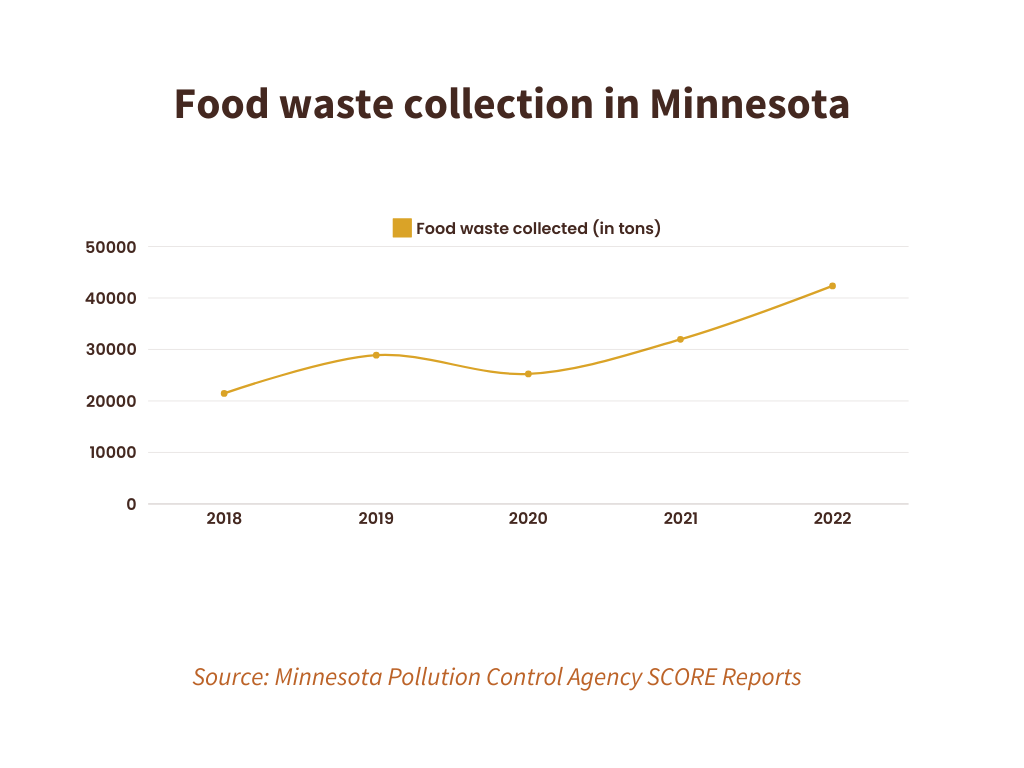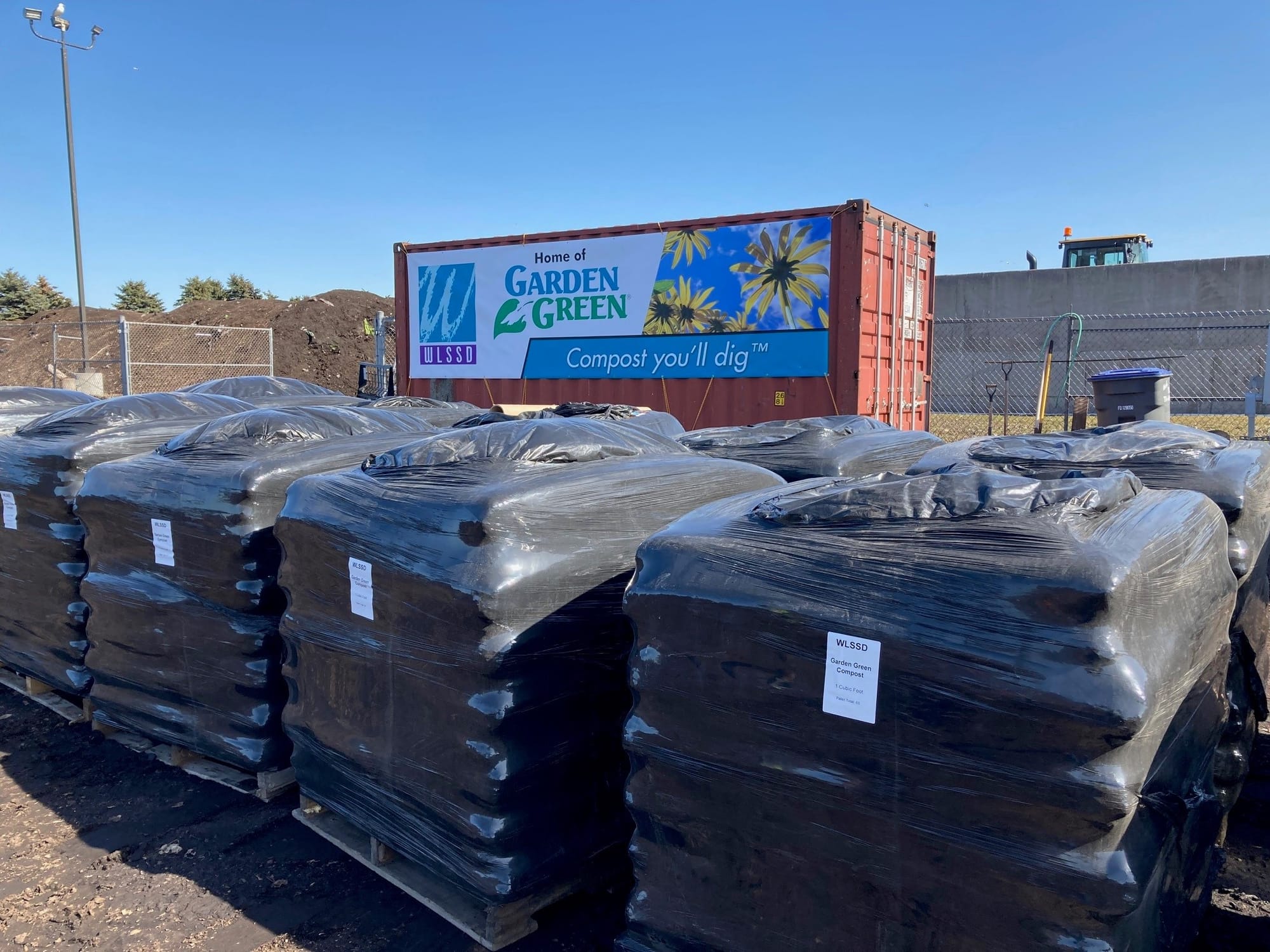Lessons learned from two decades of composting
The Western Lake Superior Sanitary District has run a compost site since 2001. During that time, the district has added 12 community drop-off sites, in addition to taking food waste from businesses.

This story was updated on Thursday, Nov. 14, 2024 to correct the number of drop sites directly overseen by WLSSD and to reflect the fact the compost site accepts BPI-certified compostable products, including napkins and serve ware. Project Optimist regrets the errors.
DULUTH, Minn. – Servers at the Duluth Grill Family of Restaurants don’t mind separating food scraps from trash.
“We have more food waste bins around the restaurant than not,” said Dan LeFebvre, managing partner. “I think it just takes an extra step. And for a lot of the employees, it becomes second nature once it's implemented.”
Food waste is a big problem. Nearly two-thirds of the food Minnesotans toss could have been eaten, according to estimates from the Minnesota Pollution Control Agency.
Nationally, 30-40% of the food Americans eat is wasted, according to the USDA. When food is wasted:
- It’s not available to be rescued by food banks, such as Feeding America.
- The resources used to create it, such as land, water, labor, and energy, are wasted, too.
- It often ends up in landfills where it emits greenhouse gasses.
Here’s the good news
Minnesotans have been recycling food waste in larger numbers over the past five years, according to MPCA data.

Composting keeps food waste out of landfills. There are 11 large-scale community compost sites across the state, including the one at Western Lake Superior Sanitary District, that aim to turn that food waste into compost.
In 2023, Western Lake Superior Sanitary District collected 2,400 tons of food waste from commercial entities and community drop-off sites, said Tim Lundell, manager of solid waste services.

It started with a rule
The district started its composting site in 2001, said Dori Decker, environmental program coordinator. The district’s board created an ordinance that requires many restaurants to separate food waste and haul it to WLSSD to be composted.
The Duluth Grill has its 6-yard food waste dumpster emptied weekly, LeFebvre said.
“It's quite a bit. I would say we do just as much food waste as garbage,” he said.

And when staff separate food waste from trash, it puts waste at the top of their mind.
“I think it's creating mindfulness from the staff. It really is teaching them about sustainability,” LeFebvre said. “There's less garbage, less waste.”
It’s not just for restaurants
The district operates 12 community drop-off sites, where residents can dump food scraps free of charge, Decker said. The district also partners with Carlton County and nearby Superior, Wis., to accept food scraps from drop-sites those municipalities oversee, Decker said. The dumpsters are often in parking lots of local businesses, churches, or colleges.
Western Lake Superior Sanitary District plans to add more drop-off sites in the future.
“The interest is expanding enough that we also want to expand the drop sites to meet the needs and the demands and to be more accessible to more folks,” Decker said.
Sign up for Project Optimist's newsletter
Solution-focused news, local art, community conversations
It's free. No spam. Unsubscribe anytime.
People have reached out to Decker to let her know the impact in their lives.
“Keeping food waste out of their garbage … can help them get a smaller garbage cart,” she said. “And so that costs them less to have garbage service when they're keeping their food scraps out of the garbage.”

A break from tip fees
A tip fee is the cost a commercial hauler pays to dump waste by weight, which usually gets passed on to the hauler’s clients. Some communities charge tip fees on food waste. WLSSD doesn’t, Lundell said.
So while restaurants in Duluth have to pay to have their food waste picked up, a tip fee doesn’t factor into the cost.
“Our goal is to get the material out of the waste,” Lundell said. “We're not looking to create this big, big profit machine here.”

It costs Western Lake Superior Sanitary District about $420,000 annually to operate the compost site, which includes all employees who work at the facility. That figure does not include the cost of collecting food scraps from community drop-off sites.
“We can recover about a third of that with our revenues from selling the product.
Odors, aesthetics pose a challenge
As far as obstacles, stinky smells top the list, Lundell said. And there’s the look of the dumpster.
Officials have also found that it’s more difficult to get a drop-off site near apartment complexes and in lower income neighborhoods.
Furthermore, some people may not have a vehicle to drive their food waste to a drop site, or they may not want to transport their food waste in their car.
Spills near the dumpsters can also attract flies, Decker said.
 Project OptimistJen Zettel-Vandenhouten
Project OptimistJen Zettel-Vandenhouten
To mitigate those issues, Decker said she builds relationships with the organizations and businesses that host drop-off sites.
“We just want to be as respectful as possible to those hosts and just honor their commitment to provide the service for the community. And we try to stay on top of some of those issues that come up,” Decker said.
To reduce spills, district officials encourage people to store their food scraps in compostable bags, she said. Western Lake Superior Sanitary District recently installed dispensers next to drop-off bins so residents can grab clean bags for free.
Food, BPI-certified items only
The compost site accepts food and Biodegradable Products Institute-certified compostable bags, napkins, and serve ware, Decker said.
Officials only allow BPI-certified products in the compost "because of their reputability with certifying products that are truly compostable, and also won't leave behind chemicals in the compost," she said.
However, facilities may have expired food they don’t want to remove from the packaging, but the equipment needed to process that is expensive, said AJ Axtell, Western Lake Superior Sanitary District’s director of community relations.
“We recognize that that's a huge portion of the organics that's going into the landfills … we're starting to get messages from some commercial entities, like, ‘Look, we need to go to a place that has de-packaging. That's important to us.’ So I think as these programs evolve, it's something that will likely be in our future.”
A high-end end product
The food waste WLSSD collects eventually becomes compost that is available for sale. The compost sells out every year, Lundell said.
People who compost their food scraps through the district and buy compost from Western Lake Superior Sanitary District in the spring appreciate the fact they’re closing the loop on waste, Lundell said.

The district sees dividends from the time and resources officials invest to educate the public on composting.
“Our product … is a really high-end compost product,” Lundell said. “It's very clean, and that is due to the work that we do on the front end to educate the users of the sites, the businesses that are bringing material in, and that supervision we provide to ensure a clean feedstock allows us to produce this product that is really desirable.”
